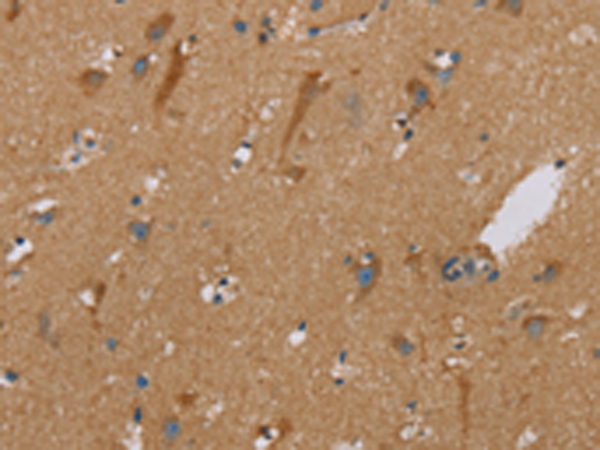


| WB | 咨询技术 | Human,Mouse,Rat |
| IF | 咨询技术 | Human,Mouse,Rat |
| IHC | 1/50-1/200 | Human,Mouse,Rat |
| ICC | 技术咨询 | Human,Mouse,Rat |
| FCM | 咨询技术 | Human,Mouse,Rat |
| Elisa | 1/1000-1/2000 | Human,Mouse,Rat |
| Aliases | DOBI; CCDC139 |
| WB Predicted band size | 60 kDa |
| Host/Isotype | Rabbit IgG |
| Antibody Type | Primary antibody |
| Storage | Store at 4°C short term. Aliquot and store at -20°C long term. Avoid freeze/thaw cycles. |
| Species Reactivity | Human, Mouse |
| Immunogen | Synthetic peptide of human PUS10 |
| Formulation | Purified antibody in PBS with 0.05% sodium azide and 50% glycerol. |
+ +
以下是关于PUS10抗体的3篇参考文献及其简要摘要:
---
1. **文献名称**:*PUS10-mediated pseudouridylation of lncRNA HOTAIR promotes cell proliferation in colorectal cancer*
**作者**:Li X, et al.
**摘要**:该研究揭示了PUS10通过催化长链非编码RNA HOTAIR的假尿苷修饰,增强其稳定性并促进结直肠癌细胞增殖。研究中利用PUS10特异性抗体进行免疫沉淀和Western blot分析,证实了PUS10与HOTAIR的直接相互作用及其促癌机制。
---
2. **文献名称**:*PUS10 regulates apoptosis via modulating mitochondrial RNA modifications*
**作者**:Zhang Y, et al.
**摘要**:作者发现PUS10在线粒体RNA的假尿苷化修饰中起关键作用,并通过调控Bcl-2家族蛋白表达影响细胞凋亡。研究使用PUS10抗体进行免疫荧光和蛋白质定位实验,证明其在细胞应激条件下向线粒体的转位。
---
3. **文献名称**:*Developmental regulation of PUS10 during spermatogenesis and its interaction with Piwi proteins*
**作者**:Wang H, et al.
**摘要**:本研究探讨了PUS10在小鼠精子发生中的动态表达模式,发现其与Piwi蛋白相互作用参与生殖细胞RNA代谢。通过PUS10抗体的免疫组化分析,揭示了其在睾丸组织中的阶段特异性定位。
---
**备注**:若需获取具体文献,建议通过PubMed或SciHub输入标题或作者姓名查询全文。实际研究中,PUS10抗体的应用多集中于RNA修饰机制及疾病模型的功能验证方向。
**Background of PUS10 Antibody**
PUS10 (Pseudouridine Synthase 10) is an enzyme belonging to the pseudouridine synthase family, which catalyzes the isomerization of uridine to pseudouridine (Ψ) in RNA, a common post-transcriptional modification. This process, termed pseudouridylation, plays critical roles in RNA stability, translation, and cellular stress responses. PUS10 is implicated in ribosomal RNA (rRNA) processing, ribosome biogenesis, and apoptosis regulation. Studies reveal its dual localization in both the nucleus and mitochondria, with mitochondrial PUS10 linked to oxidative phosphorylation and metabolic homeostasis.
PUS10 contains a conserved catalytic domain and a PUA (Pseudouridine Synthase and Archaeosine Transglycosylase) domain, facilitating RNA binding and specificity. Dysregulation of PUS10 is associated with human diseases, including myelodysplastic syndromes (MDS) and mitochondrial disorders. For instance, PUS10 mutations correlate with impaired ribosome function and hematopoietic defects. Additionally, PUS10 interacts with the tumor suppressor p53. influencing apoptosis under stress conditions.
Antibodies targeting PUS10 are essential tools for investigating its expression, localization, and function. They enable detection via techniques like Western blotting, immunofluorescence, and immunohistochemistry. Research using PUS10 antibodies has highlighted its role in cancer biology, neurodegenerative diseases, and RNA modification networks, underscoring its potential as a therapeutic or diagnostic biomarker. Recent studies also explore its involvement in epitranscriptomic regulation, linking Ψ modifications to cellular adaptation and disease progression.
×